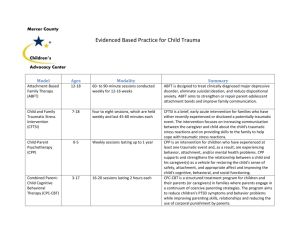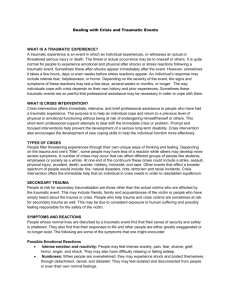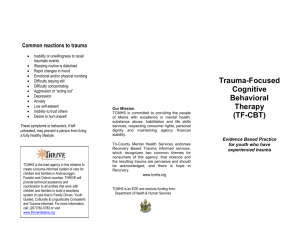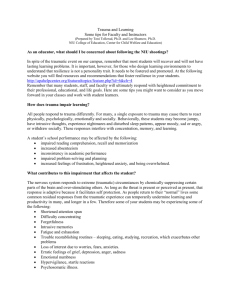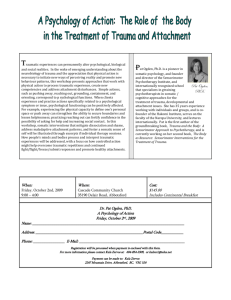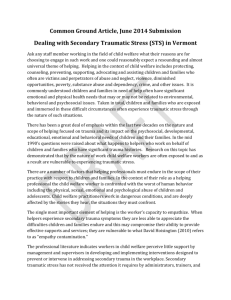Essential Skills of Trauma
advertisement
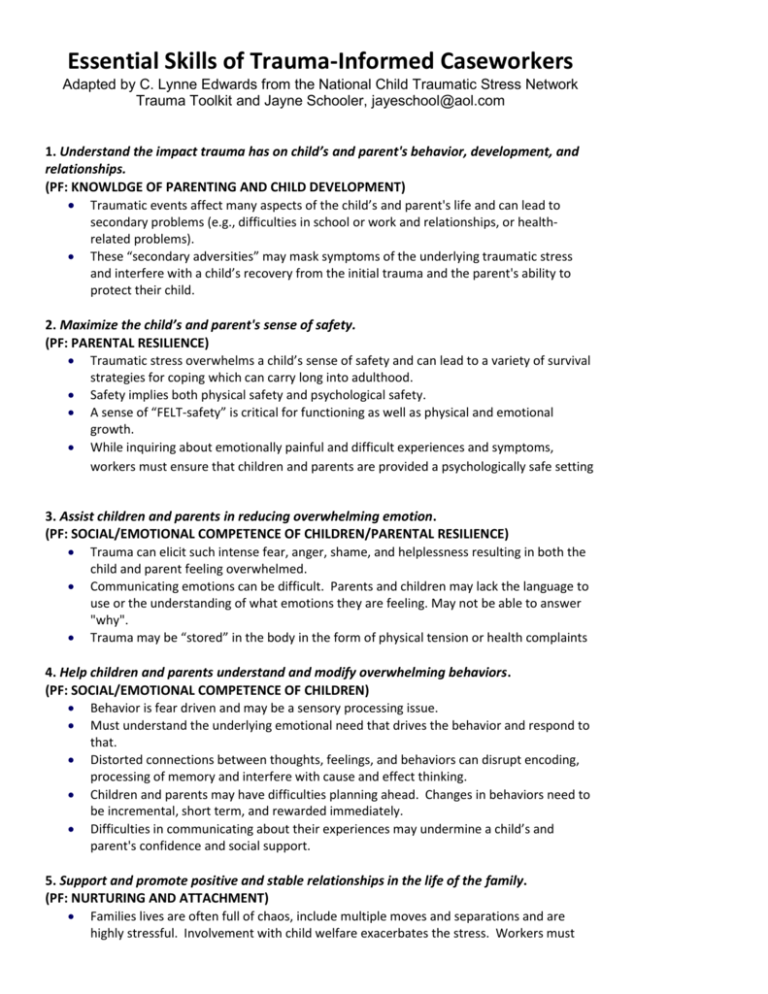
Essential Skills of Trauma-Informed Caseworkers Adapted by C. Lynne Edwards from the National Child Traumatic Stress Network Trauma Toolkit and Jayne Schooler, jayeschool@aol.com 1. Understand the impact trauma has on child’s and parent's behavior, development, and relationships. (PF: KNOWLDGE OF PARENTING AND CHILD DEVELOPMENT) Traumatic events affect many aspects of the child’s and parent's life and can lead to secondary problems (e.g., difficulties in school or work and relationships, or healthrelated problems). These “secondary adversities” may mask symptoms of the underlying traumatic stress and interfere with a child’s recovery from the initial trauma and the parent's ability to protect their child. 2. Maximize the child’s and parent's sense of safety. (PF: PARENTAL RESILIENCE) Traumatic stress overwhelms a child’s sense of safety and can lead to a variety of survival strategies for coping which can carry long into adulthood. Safety implies both physical safety and psychological safety. A sense of “FELT-safety” is critical for functioning as well as physical and emotional growth. While inquiring about emotionally painful and difficult experiences and symptoms, workers must ensure that children and parents are provided a psychologically safe setting 3. Assist children and parents in reducing overwhelming emotion. (PF: SOCIAL/EMOTIONAL COMPETENCE OF CHILDREN/PARENTAL RESILIENCE) Trauma can elicit such intense fear, anger, shame, and helplessness resulting in both the child and parent feeling overwhelmed. Communicating emotions can be difficult. Parents and children may lack the language to use or the understanding of what emotions they are feeling. May not be able to answer "why". Trauma may be “stored” in the body in the form of physical tension or health complaints 4. Help children and parents understand and modify overwhelming behaviors. (PF: SOCIAL/EMOTIONAL COMPETENCE OF CHILDREN) Behavior is fear driven and may be a sensory processing issue. Must understand the underlying emotional need that drives the behavior and respond to that. Distorted connections between thoughts, feelings, and behaviors can disrupt encoding, processing of memory and interfere with cause and effect thinking. Children and parents may have difficulties planning ahead. Changes in behaviors need to be incremental, short term, and rewarded immediately. Difficulties in communicating about their experiences may undermine a child’s and parent's confidence and social support. 5. Support and promote positive and stable relationships in the life of the family. (PF: NURTURING AND ATTACHMENT) Families lives are often full of chaos, include multiple moves and separations and are highly stressful. Involvement with child welfare exacerbates the stress. Workers must focus on reducing stress and use connecting rather than disconnecting strategies. Maintaining relationships with familiar and positive figures—family, friends, teachers, neighbors, siblings, relatives—plays an important role in supporting families who have been exposed to trauma. Minimizing disruptions in relationships and placements and establishing permanency are critical for helping children form and maintain positive attachments 6. Help the child and parents develop a strength based understanding of their life experiences and make new meaning of their trauma history and current experiences. (PF: NURTURING AND ATTACHMENT/SOCIAL/EMOTIONAL COMPETENCE OF CHILDREN) Traumatic events affect many aspects of the child’s and parent's life and can lead to secondary problems (e.g., difficulties in school, work and relationships, or health-related problems). These “secondary adversities” may mask symptoms of the underlying traumatic stress and interfere with a child’s recovery from the initial trauma and a parent's ability to change their behaviors. Secondary adversities can also lead to changes in the family system and must be addressed prior to or along with trauma-focused interventions. 7. Be an advocate/ support efforts to coordinate services with other agencies. (PF: CONCRETE SUPPORT) Traumatized children and their families are often involved with multiple service systems. A team approach should be implements for documenting trauma history, exchanging information, coordinating assessments, and planning and delivering care with other professions and caregivers. 8. Promote and support trauma informed focus assessment and treatment. (PF: CONCRETE SUPPORT) Thorough assessment can identify a child’s reactions and how his or her behaviors are connected to the traumatic experience AND can identify what's going on underneath parents' behavior to motivate them towards change . Thorough assessment can also predict potential risk behaviors and identify interventions that will ultimately reduce risk. Child welfare workers can use assessment results to guide service planning and delivery and to determine the need for referral to appropriate trauma-specific mental health care or further comprehensive trauma assessment 9. Help the family reduce their isolation. (PF: SOCIAL CONNECTIONS) Families need both concrete and social supports to reduce their feelings of helplessness, anger, and fear. Parents who have histories of childhood trauma, might be at particular risk for experiencing reactions. Parents need to be connected to resources and to understand the need for self care.


